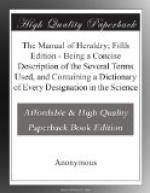VISCOUNT. A title of honour, a degree below an earl.
VOIDED. A term applied when any part of an ordinary is left open to the field.
[Illustration: Voided]
Ex. Gules, a bend sinister, voided, argent.
VOIDER. A subordinate ordinary.
[Illustration: Voider]
Ex. Azure, a voider, argent.
[Illustration: Volant]
VOLANT. The French word for flying. It is used in Heraldry to express the same action.
VORANT. Swallowing or devouring: any animal, in a charge, devouring another creature.
[Illustration: Vorant]
Ex. Argent, a serpent crowned, or, vorant an infant.
VULNED. A word that signifies wounded, used in emblazonry to denote an animal wounded by another creature.
VULNING. Any creature in the act of wounding itself.
[Illustration: Vulning]
Ex. Argent, a pelican’s head, erased, vulning.
WALLED. A term sometimes used in Heraldry. When an ordinary is edged or guarded by an embattled wall.
[Illustration: Walled]
Ex. Azure, on a pale, walled on each side with three battlements argent, an endorse gules.
WAVY. Curved lines, undulating like the waves of the sea.
[Illustration: Wavy]
Ex. Argent, the lower half of the shield three bars wavy, azure.
WHITE. This word is only used to describe a plain fur. It is represented as argent.
WINGED. When the wings of a bird, or those of chimerical figures which are drawn with wings, are of a different tincture to their bodies, they are said to be winged. Thus, in the arms of the state of Venice there is a lion sejant guardant, winged or.
[Illustration: Wings erect]
WINGS ERECT. Wings are called erect when their long feathers point upwards.
[Illustration: Wings inverted]
WINGS INVERTED. When the feathers point downwards.
WIVERN. A chimerical animal, the upper part resembling a dragon.
[Illustration: Wivern]
Ex. Argent, a wivern, wings raised.
[Illustration: Wreath]
WREATH. A chaplet of two different-coloured silks wound round each other, and placed on the top of the helmet for the crest to rest upon. In Heraldry it is usually drawn straight, as in the lower example.
* * * * *
CHAP. VIII.
HERALDRY IN CONNECTION WITH HISTORY, ARCHITECTURE, INTERIOR DECORATION, COSTUME, AMUSEMENT, RELIGIOUS SOLEMNITIES, FUNERAL RITES, ETC.
In the preface to this Manual, we stated that Heraldry might be considered as the symbolic history of the nobility of Britain, from the Conquest to the reign of Elizabeth. It would require a volume of far greater pretensions than this to enter fully upon the heraldic history of the peerage; but the assertion may be borne out by merely glancing at the supporters of the shields containing the arms of the British monarchs during that period.




